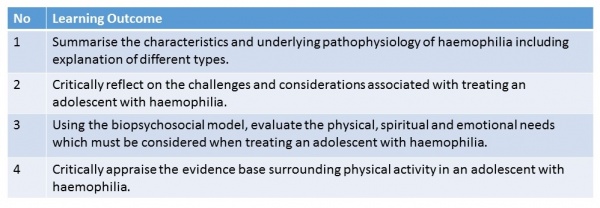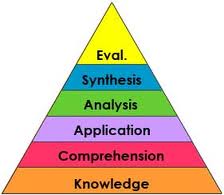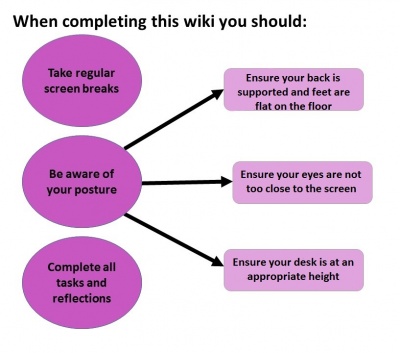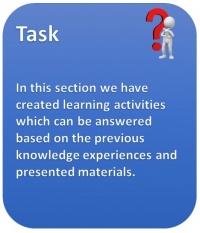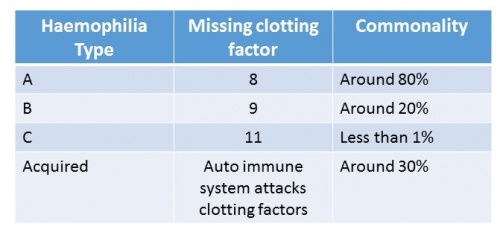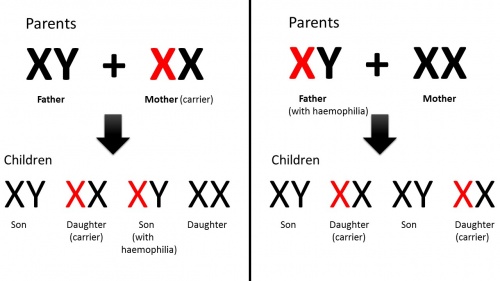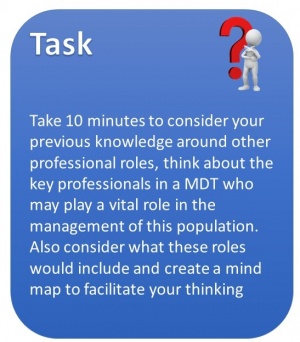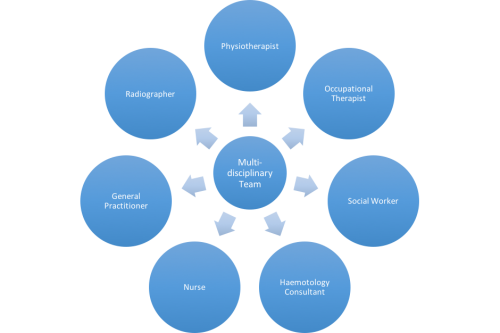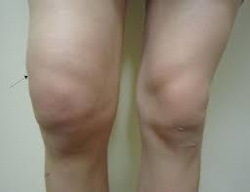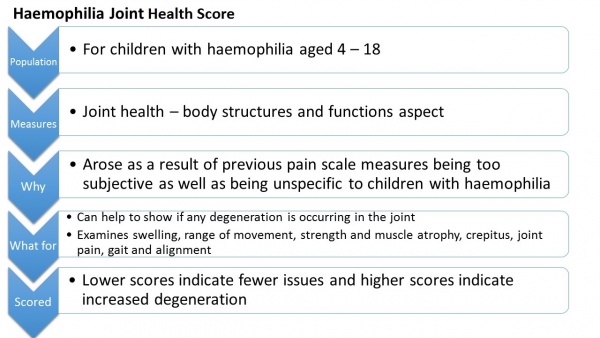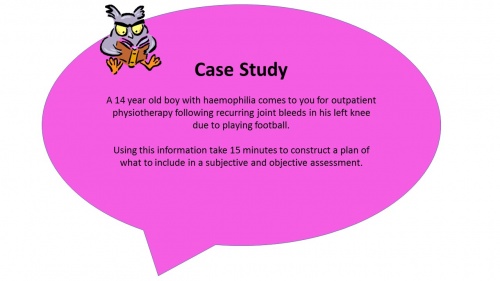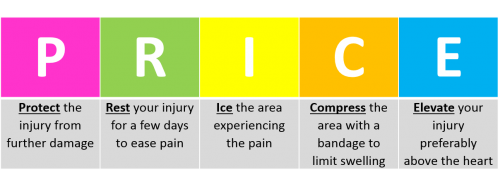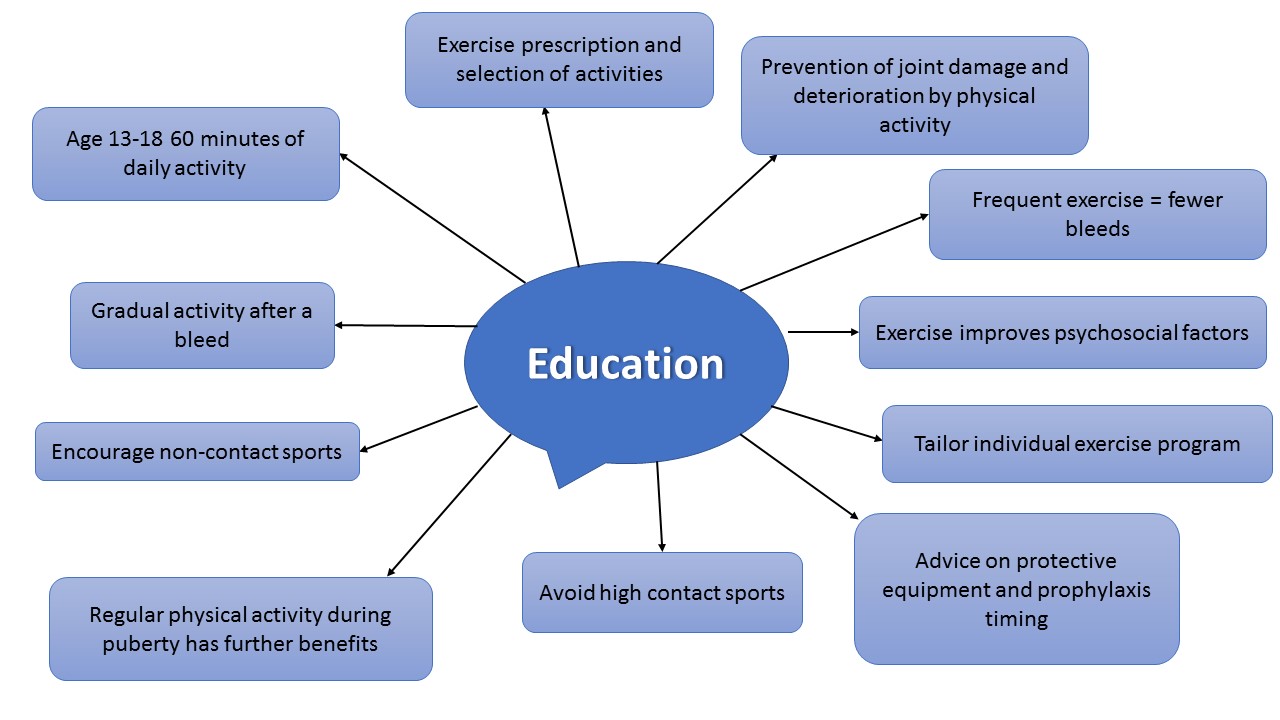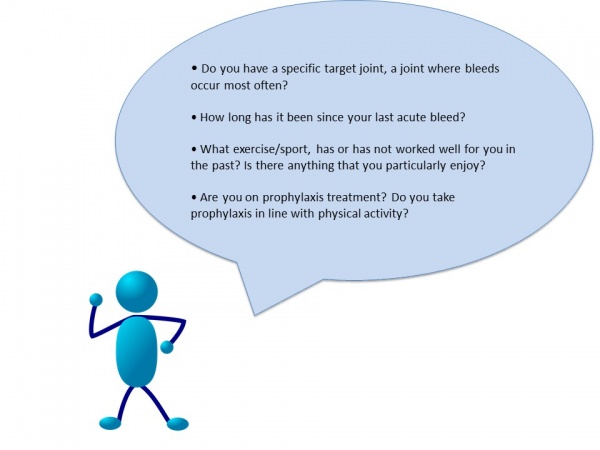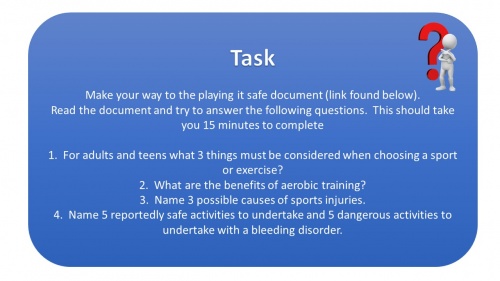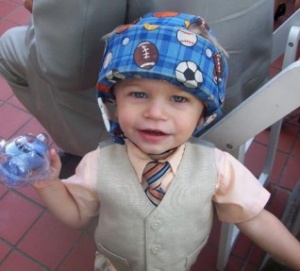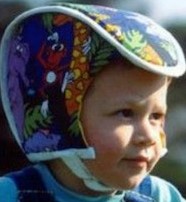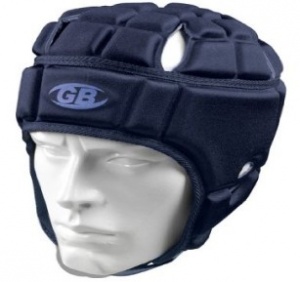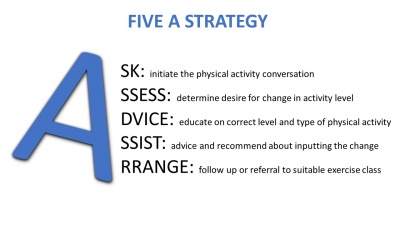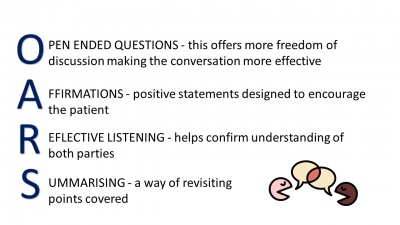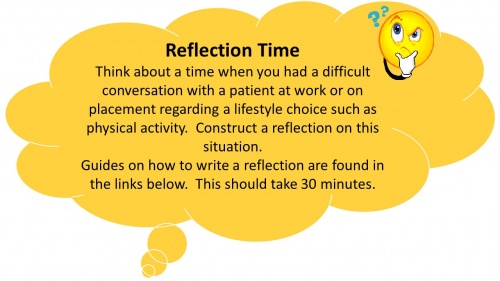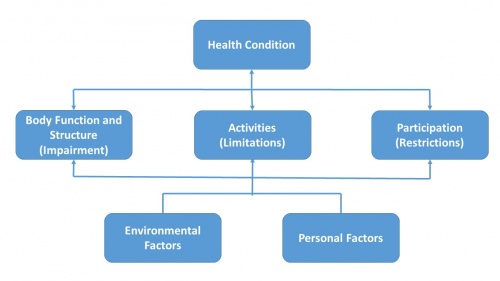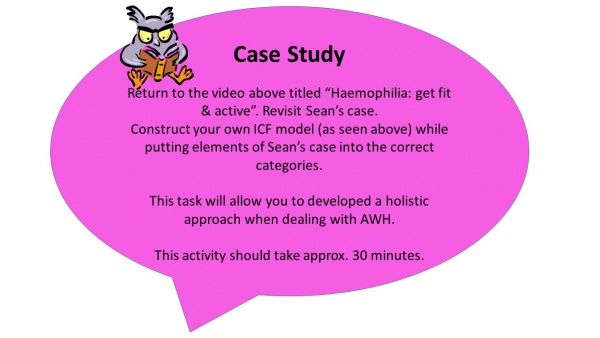Physical Activity in Adolescents with Haemophilia
Original Editor - Your name will be added here if you created the original content for this page.
Top Contributors - Caitlin MacRae, Hazel Burt, Alex Leishman, Chloe Allan, Kim Jackson, Steven flett, Rucha Gadgil, 127.0.0.1, Admin, Jane Hislop, Michelle Lee and Tarina van der Stockt
Introduction[edit | edit source]
Welcome to this online wiki resource which will focus on ‘The Role of a Physiotherapist in Promotion and Management of Physical Activity in Adolescents with Haemophilia.’ This wiki has been designed as learning resource for final year physiotherapy students and newly qualified physiotherapists. It is an online self-study module and should take approximately 10 hours to complete.
Before exploring this topic it is important to clearly define the difference between physical activity and exercise, as they will be used synonymously throughout the module.
Physical activity is defined as “as any bodily movement produced by skeletal muscles that requires energy expenditure” (WHO 2016).
Exercise is a subsection of physical activity, involving planned or structured activity which aims to improve or maintain physical fitness (Casperson et al. 1985).
We hope you find this resource useful and informative.
Aims and Learning Outcomes[edit | edit source]
The aims of this wiki are as follows:
- To present a learning resource for final year physiotherapy students and newly qualified graduates which aims to develop their knowledge and understanding of the management of adolescents with haemophilia.
- To introduce final year physiotherapy students and newly qualified graduates to the skills, competencies and resources which can be utilised within their clinical practice in order to offer more effective and comprehensive management of adolescents with haemophilia.
Learning Outcomes:
The following learning outcomes have been constructed using the levels determined by Bloom’s Taxonomy to facilitate learning development (Bloom et al. 1956). Through completion of this learning module and related tasks, final year physiotherapy students and newly qualified physiotherapy graduates will be able to:
Blooms Taxonomy, shown below, demonstrates a hierarchy of learning. This wiki aims to encompass various levels of this hierarchy throughout in order to optimise the learning of the reader. The identified learning aims have been constructed to suit this learning theory.
Why is there a need for this Physiopedia page?[edit | edit source]
The physiotherapists role in treating and managing adolescents with haemophilia (AWH) is extremely important, and recent developments within the profession have increased its value (Buzzard and Beeton 2008). One of the key interventions involved in its treatment is promotion of physical activity (World Federation of Hemophilia 2015).
As physiotherapists, we have an obligation and responsibility to actively promote physical activity in this population, as well as educating the individuals correctly in self-management of their life-long condition, the intention being to maximise quality of life (Buzzard and Beeton 2000). It is therefore essential for us to have a deep understanding of this condition and the effects and benefits of physical activity and exercise.
[edit | edit source]
The wiki is organised under the following three main sections:
- Background of Haemophilia
- The Role of the Physiotherapist
- Benefits of Physical Activity
How long you should spend working through each section:
Throughout this learning resource, various tasks, activites and additional reading have been provided to engage the learner. Examples of how these are laid out are detailed below.
|
Links to additional reading will follow this banner,
however this is optional in order to stay within the 10 hours. Please use these if you have further interest in the subject. | |
These have been developed considering different learning styles (VARK 2016). Learning styles are common ways in which people learn. These can in visual, auditory, reading and writing or kenisthetic learners. If you are unsure of your learning style, please refer to the following link provided VARK Learning Questionnaire.
Background[edit | edit source]
This chapter will offer a brief understanding of haemophilia including pathophysiology, incidence, prevalence, classification, severities and medical management. The role of the multi-disciplinary team (MDT) in treating an adolescent with this condition will also be briefly discussed.
The learning outcomes to be addressed in this section are:
1. Summarise the characteristics and underlying pathophysiology of haemophilia including explanation of different types.
Definitions, Incidence and Prevelance[edit | edit source]
Haemophilia is a rare inherited blood disorder where blood in the body has an inability to produce sufficient clotting factor, a protein in the blood which controls bleeding (NHS Choices 2015). This lack of clotting factor can lead to severe and prolonged bleeds within the body which may cause permanent damage to site of haemorrhage and surrounding tissues (World Federation of Haemophilia 2015). The condition mainly affects males and is carried genetically through a gene which is passed to child, from parent through the X chromosome (Great Ormond Street Hospital 2015)
There are four main types of Haemophilia. The table below shows the missing clotting factor and commonality for each type of haemophilia:
Haemophilia A is the most common type. This is where the individual will either have low levels of clotting factor eight or it is completely missing. This type of haemophilia affects around 80% of the haemophilic population (The Haemophilia Society 2015).
Haemophilia B is less common. This is where clotting factor nine is either very low or is missing from the blood. Around 20% of people with haemophilia will have this type (The Haemophilia Society 2015).
Haemophilia C is ten times rarer than type A. They will have low levels of clotting factor eleven or this will be completed absent. Haemophilia C is different to both A and B as it can present in both genders. This is extremely uncommon and can only happen when the mother and father are both carriers of the gene (Haemophilia Information 2013). Haemophilia C does not cause joint bleeds but can lead to nose bleeds, bleeding in the mouth, heavy bleeding during periods for girls and prolonged external bleeding following injury (IHTC 2012).
Acquired Haemophilia is extremely rare. This type is not inherited in the same way as it is an auto-immune disorder. This is where the immune system attacks the clotting factors. This condition can also affect males and females. (Grethlein 2014).
The figure below demonstrates how haemophilia is passed on genetically:
As shown above, when the female is the carrier and the father is unaffected, the son will possess a 50% chance of inheriting the condition. There is a 50% chance the daughter will be a carrier of the gene but will not inherit the condition (HFA 2015).
When the male suffers from haemophilia and the mother is unaffected, none of the sons will inherit the condition, all daughters will carry the gene but will not be affected (HFA 2015).
If the father has haemophilia and the mother is a carrier, there is a 25% chance that the daughter and son may have haemophilia. This is the only way the female can inherit the condition, however it is extremely rare.
Classifications and Severities[edit | edit source]
The table below catagorises the severities of haemophilia into mild, moderate and severe, showing the percentage of sufferers in each category (Preston et al. 2004).
Like other disorders, haemophilia can affect people to varying degrees. The symptoms can be mild, moderate or severe, depending on the level of clotting factor present (NHS Choices 2015).
In mild haemophilia the individual will have between 4% - 49% factor in their blood. Around 43-70% of the haemophilic population are considered mildly affected (Haemophilia Information 2013). Symptoms for mild haemophilia can be non-existent, although may include prolonged bleeding following serious injury, trauma or surgery. In many cases, haemophilia will not be diagnosed until there is excessive bleeding following injury or surgery. In some cases it may not even be discovered until adulthood.
Moderate haemophilic sufferers possess between 1% and 5% of factor level in their blood. 15-26% of AWH are considered moderate (Haemophilia Information 2013). Those with moderate haemophilia are likely to suffer prolonged bleeding following injury and may have occasional spontaneous bleeding episodes.
Severe haemophilia will affect an individual to a greater extent. Those with severe haemophilia will have a factor level between 0% and 1%. This accounts for the other 15-31% of the haemophilia population (National Haemophilia Foundation 2016).They will experience excessive bleeding slight injuries and surgery and are also highly likely to have spontaneous bleeding episodes into the joints and surrounding muscles (Haemophilia Information 2013). This internal bleeding is particularly dangerous as suffers may be unaware it is occurring. If untreated it can lead to permanent joint deterioration and arthritis over time.
Medical Management
[edit | edit source]
The medical management of haemophilia typically involves two treatment methods, ‘on demand’ or prophylactic. Haemophilia Care (2014) explains how treatment involves replacing the deficient clotting factor (VIII for haemophilia A and IX for haemophilia B) through intravenous injection.
On demand treatment is administered immediately following a bleed and is most commonly used in mild or moderate cases. It provides the advantage of not having to infuse regularly, however if there is a delay in ‘on demand’ treatment following a bleed then there is potential for damage to occur.
Prophylactic is administered regularly as a method of preventative management and is most commonly used in those who suffer with severe haemophilia. The ultimate goal of prophylaxis treatment is to reduce the deficiency of factor VII or factor IX (Berntorp and Shapario 2012), therefore reducing the risk of spontaneous bleeds. It also aims to reduce the severity of the condition (Nilsson et al. 1976). Khoriaty et al. (2005) explains how clotting factors are infused by the patient themselves on a constant basis around three times a week in the case of severe haemophilia A (factor VIII), and twice a week in severe haemophilia B (factor IX). The World Health Organisation (xxxx) recognises prophylaxis treatment as the optimal treatment for patients with severe haemophilia.
| For more information on the medical management of haemophilia please visit the following link WFH Guidelines for the management of haemophilia Pages 12-14. Take 10 minutes to do this. |
MDT Involvement
[edit | edit source]
Before continuing onto this section complete the task below.
Despite recent development in management of the condition, PWH still require comprehensive multidisciplinary care through all stages of their life (Breakey et al. 2010). A multidisciplinary team involves a range of professionals who collaborate together to structure a treatment plan for an individual, aiming to achieve high quality patient-centered care (Department of Health 2015).
The collaboration of all professionals allows a holistic approach to be considered which takes into account the individual’s physical, social, emotional, cultural and spiritual needs (CSP 2015). This is especially important during transition from childhood into adulthood which can cause additional stress for those with chronic disorders. Therefore during this time the need for the MDT to work together is essential (Breakey et al. 2010). This may mean referring the patient to another team member to allow high quality treatment, specific to the patients needs.
The following mind map provides examples of professionals that may be involved in the treatment of an AWH.
Quiz[edit | edit source]
Follow this link to a quiz on the background of haemophilia as seen above. This should take approximately 5 minutes to complete. Please check your answers below.
The Role of The Physiotherapist[edit | edit source]
This section of the wiki will examine the role of the physiotherapist broken dow assessment, management, education, physical activity promotion, considerations, personal protective equipment and how to approach a conversation regarding physical activity.
The learning outcomes to be addressed in this section are:
2. Critically reflect on challenges and considerations associated with treating an adolescent with haemophilia.
Assessment
[edit | edit source]
One way physiotherapists can objectively assess AWH is through use of standardised outcome measures. These offer an objective measure which allows you to evaluate change in a patients symptoms (REF).
Symptoms of a joint bleed may include swollen and hot joints, pain in the area and stiffness when mobilising. Many patients have described the overall feeling as an 'aura' surrounding the joint. (REF) The image below shows severe swelling in the left knee during a joint bleed:
The Haemophilia Joint Health Score (International Prophylaxis Study Group 2015) is designed for physiotherapists and recommended for use by professionals specialised in haemophilia treatment. The outcome measure takes approximately 45 – 60 minutes to complete and is designed specifically for children with haemophilia. It examines the condition of a joint affected by a bleed and can be used to demonstrate the degeneration of a joint over time.
The Paediatric Haemophilia Activities List’ is another outcome measure used for individuals with haemophilia. Adolescents will complete the child/teenager version explaining to what extent their haemophilia impacts upon their daily activities The questionnaire can then be used by healthcare professionals involved in their care (World Federation of Haemophilia 2011).
There are limited outcome measures specific to AWH (REF). Physiotherapists play a key role in assessing the joints affected by haemophilia, however it is also helpful for physiotherapists to be aware of other existing measures avialable in order to rehabilitate a patient appropriately.
Before continuing on to physiotherapy management take some time to complete the case study below, based on what you have read and using your own knowledge:
After completing your own plan see the table below of our plan of assessment.
Management[edit | edit source]
The main role of the physiotherapist in treating adolescents with haemophilia involves management of impairments from a musculoskeletal perspective, aiming to restore and improve function. Some of these include: haemarthoses, synovitis, joint contractures, haemotomas and haemophilic arthropathys (Buzzard and Beeton 2000).
A common presentation as a result of injury during sports or equally due to adverse affects associated with inactivity can be joint bleeds. Therefore it is important we are able to manage these appropriately.
During the acute phase, the physiotherapist will attempt to minimise bleeding using the PRICE regime (protection, rest, ice, compression elevation) (Haemophilia Care 2014). This will also work in conjunction with factor replacement if necessary.
Following the acute phase, the physiotherapy management will focus on regaining full range of movement, muscle strength and reducing pain (REF). As soon as the pain and swelling begin to decrease, the patient should be encouraged to gradually increase the joint range aiming to achieve complete extension. This should be done actively by the patient to encourage muscle contraction, however passive movements may initially be used. It is vital that early active muscle control occurs to prevent the loss of joint movement (Hermans et al. 2011; Gomis et al. 2009; Mulder 2006). Rehabilitation involving active exercises and proprioceptive training must then be continued until full pre-bleed joint ROM and function is restored (Heijnen and Buzzard 2005).
As previously discussed, another key role of the physiotherapist when treating an AWH is promotion of physical activity. Exercise is encouraged as it will improve the child’s fitness, reduce obesity levels, improve muscular strength, and reduce frequency of bleeding episodes and joint deterioration (Blamey 2010). The World Federation of Haemophilia (2012) advise particular focus towards strengthening, co-ordination, achieving a healthy body weight and improving self-esteem.
As well as the physical aspects concerned, a major aspect of physiotherapy management focuses on education and advice. This is discussed in detail within the following section.
Education
[edit | edit source]
Below is a mind map which summarises key points regarding the advice that should be given to patients regarding physical activity.
The physiotherapist has a crucial role in educating patients regarding physical activity, exercise prescription and selecting particular activities[1].
It is important to ensure patients, relatives and peers are made aware of the positive impacts of physical activity, helping to prevent joint damage and functional impairment[2]. Also, individuals who exercise frequently actually experience fewer bleeds[3].
You should inform patients that just as with healthy individuals, exercise also improves psychosocial wellbeing[4]. It is also important to stress the added benefits of physical activity during puberty in adolescents. Regular physical activity during puberty, enhances lean tissue mass, fitness and strength and decreases fat mass (Ara et al. 2004).
Depending on the severity of the condition, as the physiotherapist you must then advise the patient that high contact and collision sports such as ice hockey, rugby, boxing, and wrestling are usually not advised. You can then attempt to encourage non-contact sports such as swimming, walking, cycling, golf, archery, badminton, rowing and sailing [5].
You must work in conjunction with the medical team when advising timing of prophylaxis that is appropriate to their chosen sport or activity (McGee et al 2015; The World Federation of Hemophilia 2015). It may also be necessary, where appropriate, to educate and encourage the use of protective equipment e.g if patient has a target joint, or does not take prophylaxis prior to activity (Philpott et al. 2010). Protective equipment is discussed in detail later in the module.
As the physiotherapist you may also be involved in educating school personnel regarding suitable activities for the child, immediate care in case of a bleed, and modifications in activities that may be needed following bleeds (The World Federation of Hemophilia 2015).
Physical Activity Promotion[edit | edit source]
It is already known that physical activity in this population is reduced compared to healthy age-matched peers. The kings fund (xxxx) acknowledge health behaviour patterns to impact an individual's overall health by as much as 40%, when compared to healthcare which contributes only 10%. Therefore as Physiotherapists our role in health and activity promotion is crucial in order to influence positive behavioural change to impact upon health (CSP 2016).
Health promotion involves supporting people to gain control and responsibility over improving their own health. It extends beyond focusing on individual behaviour and includes a variety of social and environmental interventions (WHO 2016).
The Corporate Policy and Strategy Committee have introduced a Physical Activity for Health Pledge which the NHS is engaging with. This pledge involves ensuring primary care staff have the necessary skills and resources available to assess physical activity levels. It also ensures they offer education detailing recommended minimum requirements for physical activity, brief advice and intervention, along with increasing awareness of available community resources. Unpublished data from NHS Health Scotland reveals only 13% of primary care practitioners are presently aware of the recommended weekly activity levels (Corporate Policy and Strategy Committee 2015). It can therefore be assumed this is not currently being promoted effectively.
The following video "23 and a 1/2 hours" strongly promotes physical activity for 30 minutes of your day. Although not specific to the haemophilic population, however the take home message can be followed for AWH as the physical activity benefits are not changed or exhaustive.
Although various studies have described the benefits of engaging in physical activity for people with haemophilia (PWH), results from research conducted in the USA among adolescent haemophilia patients have demonstrated a lack of knowledge concerning the role of physical activity in managing their condition (Nazzaro et al. 2006). Whilst it is recognised this information is important, this study has not been conducted in the UK. This suggests that more work must be done to promote physical activity and emphasise its positive role in enhancing the lives of PWH (Negrier et al. 2013).
Physical activity promotion for health exists worldwide (Heath et al. 2012). The benefits of such in the general population are widely known, providing health improvements along with the potential for enhancing disease outcomes (WHO 2015). National and international guideliness set out clear recommendations on the physical activity levels required to promote health (Department of Health 2011). Although many studies have reported the benefits of participation in physical activity for PWH, researchers in the USA have identified a lack of knowledge among
young haemophilia patients (aged 13–18 years) as to the role of exercise in the management of their condition.
The promotion of exercise in AWH is of particular importance due to recent advances in care over the past 40 years (Manco-Johnson et al. 2003). This has seen changes in exercise prescription; as is it now believed to be a crucial modality and understood it will not attribute to bleeds, as previously believed (Riske 2007).
Considerations
[edit | edit source]
As the physiotherapists it is vital to be aware of risks and considerations when advising patients to participate in physical activity.
When discussing forms of exercise with the patient, the following information is essential to obtain from your patient;
Knowing whether patients have target joint bleeds allows the physiotherapist to adapt and alter your advice and treatment plan. This will allow you to discuss the use of protective equipment for the target joint, or if there are any other activities which may reduce the risk of contact involving that specific joint.
As discussed previously, it is important to know when the patient’s last acute bleed was and where. Activity must be gradually re-introduced following a bleed to minimise the chance of it reoccurring (The World Federation of Haemophilia 2015).
It is important to discuss with the patient what exercises they enjoy. This way it is much more likely you will be able to actively promote activity.
Appropriate timing of prophylaxis treatment surrounding physical activity is critical when striving to prevent bleeds. Prophylaxis should be individualised and taken to coincide with exercise. The aim being the factor will be at its peak during the period of activity (Anderson and Forsyth 2005). This will minimise the risk or potential for bleeds (WFH 2012). As discussed previously, you must be aware of this and communicate with the patient’s medical team regarding best advice.
Guidelines and Recommendations[edit | edit source]
It is important to note that the recommended guidelines for physical activity in children with haemophilia are the same as those advised for healthy individuals. Government issued guidelines exist for children and young people aged 4 – 18. These guidelines state that this age group should be participating in 60 minutes of moderate to vigorous activity each day. Vigorous activity, which strengthens muscle and bone, should take place at least 3 times a week (Physical Activity Guidelines for children and Young People 2011).
The World Haemophilia Federation (2012) has released updated guidelines for the management of people with haemophilia:
- The primary aim of management is to prevent and treat bleeds
- Comprehensive care aims to promote health physically and psychosocially, as well as improving quality of life and reducing morbidity and mortality. Physiotherapists may play a more significant role in this aspect compared to managing the more acute phase of a bleed. Physiotherapy involvement contributes to both the prevention and treatment of bleeds.
- Children and adolescents should be seen every 6 months by a physiotherapist for assessment and management planning
- Physiotherapy has a main role in promoting physical activity: to promote fitness, neuromuscular development, strengthening, coordination, functioning, weight management and self esteem
- Weight bearing activities should be encouraged to encourage bone mineral accrural
- The development of a physical activity plan should be tailored to individuals preference, abilities and severity of condition
- Non-contact sports will be encouraged – i.e. swimming, walking, golf, badminton, cycling, table tennis
- Contact sports and high velocity sports are strongly discouraged due to the risk of a fatal bleed – i.e. rugby, boxing, wrestling, racing, skiing
- Target joints can be protected using braces or splints during activities
- Following a bleed the activity should be reintroduced gradually to minimise the risk of re-bleeding
- Adjunctive management is also vital to physiotherapy. This means activity should be undertaken in conjunction with factor replacement. Physiotherapy can also help reduce the amount of factor necessary.
- In the acute phase, PRICE will be used by the physiotherapist
- Following this, rehabilitation is required to restore function
"Playing it Safe" (Haemophilia, 2005) is an online document which provides recommendations and advice regarding partaking in sports and exercise if when suffering with a bleeding disorder.
This document offers recommendations on the safest activities to participate in and gives advice on the sports and exercises with the highest risk of injury.
For adolescents, when considering which activities to take part in, it is important to consider current body condition, history of bleeding and joint condition.
It is also proven the more physically active you were through childhood the easier it will be to remain active in teens and into adulthood.
As children become teenagers some sports such as basketball become more contact – therefore although these sports may have been possible when they child was younger it may have more risks in adolescents.
Use this link to complete these questions - Playing it Safe
|
Click on the following link to view the 'UK Physical Activity Guidelines' from the Department of Health:
|
Personal Protective Equipment[edit | edit source]
Protective equipment can be worn by individuals to minimise risk of bleeding either at a very young age or when taking part in sports and activities at an older age (WHF 2007). This is generally used considering personal preference, the child’s compliance and level of sporting activity undertaken. Splints or braces can be useful in protecting target joints whilst participating in sports (WFH 2012).
Joints which are considered a high risk of bleeds are the elbows, wrists, knees and ankles. Toddlers are encouraged to be protected with elbow and knee pads when crawling and helmets can also be beneficial to protect children from falls, especially when cycling or running. Due to the introduction and advances in prophylaxis, the need for protective equipment in day to day activities has been reduced. It has been suggested that although previously considered extremely important and beneficial, nowadays the social risks outweigh the potential benefits of protective equipment when partaking in everyday activities. However, this is a decision that has to be made based on the type and competitiveness of the activity the individual is participating in.
There are many different types of protective equipment available and multiple ways of modifying home environments to make it safer for toddlers and young children.
An example of the various different types of protective equipment are shown in the table below:
Through researching the topic of personal protective equipment relating to haemophilia and physical activity it is clear that there is a limited amount of literature and lack of studies in this area. More recent studies focus on physical activity with the use of prophylaxis as the development of treatment has reduced the need for protective equipment during physical activity.
How to Approach Conversations Regarding Physical Activity[edit | edit source]
It can sometimes be difficult for a physiotherapist to approach a conversation regarding how much physical activity a person undertakes. It can often be challenging to encourage change in a person’s behaviour and can be increasingly difficult in adolescents with haemophilia due to the nature of the condition. This a particularly difficult issue in adolescents with haemophilia as this is normally a stage in their life where physical activity levels reduce (REF). However physiotherapists can offer education and advice about what type of activity to undertake in order to prevent bleeds occurring. More recommendations about this have been discussed previously in the education and recommendations sections.
Appropriate communication is essential when discussing physical activity with patients. The Royal College of General Practitioners (2014) makes recommendations on how to communicate ideas to a patient:
• Be aware of the amount of information you provide – careful not to overload them
• Avoid the use of technical vocabulary as it may cause confusion
• Use different methods other than verbal communication to provide information e.g. leaflets, video, online resources.
Brief interventions involve short advice and support sessions providing information for the patient regarding the process of behavioural change. One method of brief intervention is the 5 A Strategy (Sim et al. 2009). The picture on the right shows what this involves:
Finally OARS is a form of motivating the patient through communication. The diagram below explains how to use OARS:
Complete the reflective task below. Think if this conversation could have improved using the techniques above.
To help you construct a reflection you can use reflective models such as Gibbs or Rolfe.
Benefits of Physical Activity[edit | edit source]
In this section of the wiki, benefits of physical activity in AWH will be discussed. This will include physical inactivity and obesity, childhood development, psychosocial factors associated with physical activity and supporting evidence.
The learning outcomes to be addressed in this section are:
3. Using the biopsychosocial model, evaluate the physical, spiritual and emotional needs which must be considered when treating an adolescent with haemophilia.
4. Critically appraise the evidence base surrounding physical activity in an adolescent with haemophilia.
NHS Lothian - Haemophilia: Get Fit & Active
[edit | edit source]
Physical Activity Relating to Obesity[edit | edit source]
Recent progress in the management of haemophilia over the past few decades has seen improvements in average lifespan of AWH, now matching that of a healthy individual (Darby et al. 2007). These changes however, have introduced other new issues to tackle in the coming years.
Childhood obesity is prevalent in AWH, as well as the general population. However, the consequences of weight gain in sufferers can cause additional issues, such as increased risk of joint arthropathy (Young 2012). Excess weight can induce joint bleeds due to added stresses placed on the joints (Biere-Rafi et al. 2011). Effects of obesity and overweight can also exacerbate existing arthropathies and influence development of cardiovascular disease (Douma-van Riet et al. 2009).
Parental influence is also considered to be a contributing factor to obesity and overweight in this population. Many parents tend to be very protective over their child, preventing them from engaging in physical activity. It was not until the 1970s that exercise in this population was recognised as effective. Prior to this it was considered to increase the risk of haemarthroses (Broderick et al. 2006). A previously discussed, it is now recommended for particular activities, mainly swimming, with aims of improved quality of life. This new treatment approach is largely due to recent advances in safety and availability in the clotting factor used to prevent bleeds (Querol et al. 2010). Buzzard and Beeton (2008) also report evidence to suggest changes in blood clotting factors due to exercise.
The benefits of physical activity in the general population are widely known, providing general health improvements along with potential enhancement in disease outcomes (ref). However, Philpott et al. (2010) believe children suffering with a chronic disease or disability are less active than their age-matched healthy peers. A study conducted by Hofstede et al. (2008) comparing healthy subjects to AWH reiterates; revealing triple the number of obese boys with haemophilia in relation to the comparable healthy subjects. Contrary to this finding, a 2010 study quantifying physical activity levels through accelerometry, revealed AWH to be more involved in physical activity compared to their healthy peers. However, the study also stated the time dedicated to physical activity was mainly focused towards low-intensity activities and sedentary behaviours (Buxbaum et al. 2010). Several studies have reported an association between an increase in obesity levels and sedentary behaviours particularly amoung AWH. This increase is concerning, however does not differ much from the un-affected population (Hosftede et al. 2008;Douma-van Riet et al. 2009).
There is lacking evidence available to claim that there is a true correlation between reduced exercise levels in AWH and increased weight or obesity and further study must be carried to clarify these findings. However, this information confirms the need for lifestyle modifications in this population, including dietary changes and promotion of physical activity. The overall consensus, as previous stated, is that an accumulation of 60 minutes or more physical activity of moderate intensity, consisting of both aerobic daily activity and vigorous intensity aerobic activity across a minimum of 3 days per week is advised (WHO 2010; Licence 2004). However, the physical activity recommendations remain limited (Beardsley 1995; Buzzard 1996), with findings from recent studies demonstrating controversial outcomes.
Childhood Development[edit | edit source]
Adolescents undergo more physical changes at this age than throughout any other stage of life after birth. Rate of growth in itself can predispose the child to bleeds. Growth spurts around puberty may decrease the muscle mass surrounding joints and consequently increase joint bleeding during this period (Johnson and Gorlin 2013).
Weight-bearing activity is crucial in ensuring adequate generation of bone mass throughout childhood and may be even be considered more important than calcium intake through diet (Barnes et al. 2004). A study conducted in 2008, by Tlacuilo-Parra et al. revealed a significant reduction in lumbar spine bone mineral density in children with haemophilia in comparison to healthy subjects of matched age and sex. The results demonstrated statistically significant differences in activity between the groups, with the haemophilia population at three times the risk of inactivity. These results confirm that long periods of inactivity and immobility, with reduced weight-bearing (such as following joint bleeds) are directly related to low bone mineral density in AWH.
Psychosocial factors associated with physical activity
[edit | edit source]
Due to the nature of the condition, AWH are usually diagnosed and aware of their condition from a very young age. The childs parent or guardian will also be affected due to their involvement in the care and management of the individual in the early years. (The World Federation of Haemophilia xxxx) There are psychosocial, as well as physical barriers which can be managed using the ICF model. (REf)
Recent evidence discussed throughout this wiki resource supports exercise, allowing AWH to participate in peer activities which they would have previously been excluded from.
The World Federation of Haemophilia (WHF) separates a number of different psychosocial issues into specific age groups:
• Infant to toddler (newborn to age 5)
• Early childhood (6-9 years)
• Pre-adolescence (10-13 years)
• Adolescence (14-17 years)
• Adulthood (18 years +)
It is important that at every stage of the child’s journey there is help and support available to the individual and family to ensure that psychosocial barriers are minimised (Cassis, 2007). Some of the psychosocial issues that are common in adolescence are discussed below.
Transition phase
In the adolescence stage, where there is a transition of care from paediatrics to general practitioners. At this stage it is important to focus on self -management and independence in treatment. From pre-adolescence to late teenage years, individuals will become more independent and involved in managing their condition and self- treating. Although this leads to increased confidence in their own bodies as they are able to confidently treat themselves, a common barrier with this at this age is compliance.
Compliance
Cassis (2007) states that at this stage developmentally, teens are focussed on present events and do not consider the future consequences that poor management of their condition could cause. Also as a child starts to mature, other activities may take more of a priority over physiotherapy or exercises and it is important that they are made aware of the harmful consequences that this could lead to.
Physical activity can play a large part in a child’s social and emotional well-being. Through team-based sports they learn how to work with other peers. Improved emotional status has also demonstrated marked clinical benefits with reported reductions in spontaneous bleeds (Anderson and Forsyth 2005).
Cassis et al 2012 conducted a systematic review which looked at 24 studies relating to the psychosocial aspects of haemophilia. It found that psychosocial factors have a significant impact on quality of life for patients with chronic conditions such as Haemophilia. One of the studies, found that in haemophilia one of the most common stressors associated with psychological factors is limitations to an active lifestyle including sports and other physical activities. This may be due to the fear of causing a bleed or stigma associated with the protective equipment that is sometimes required to safely participate in sports. (REF).
The literature review also found that for PWH, participation in physical activites and sports is associated with positive effects not only for physical well-being but also on self-esteem and social interactions. This is supported further in a study by Sherlock 2010 which found that the non-physical benefits of sporting activities included improved self-esteem and perceived social acceptance. It also supported the above view that quality of life in PWH is impaired by limitations in sporting activity.
However, Buxaum et al 2010 conducted a study which aimed to ascertain social and cognitive factors associated with exercise in PWH aged between 11 and 18. The Peirs Harris Childrens Concept Scale and the Childrens Manifest Anxiety Scale are self-reported scales that were used to measure self-esteem and anxiety in PWH. This study found no differences in the scores obtained in these outcomes between PWH and healthy controls. Although this conflicts with previous evidence only 17 participants in the Haemophilia group were recruited and therefore results must be taken with caution due to small sample size.
Although results are supported well by similar studies, it is evident that research into the psychosocial aspects of haemophilia is limited (cassis 2012) and actual participation in physical activity among PWH has not been well studied (Buxaum 2010)
Supporting Evidence[edit | edit source]
Conclusion[edit | edit source]
Recent Related Research (from Pubmed)[edit | edit source]
Extension:RSS -- Error: Not a valid URL: Feed goes here!!|charset=UTF-8|short|max=10
References
[edit | edit source]
- ↑ Heijnen L. Rehabilitation and the role of the physical therapist. Southeast Asian J Trop Med Public Health. 1993;24(Suppl. 1):26–9. http://www.ncbi.nlm.nih.gov/pmc/articles/PMC3570911/ (accessed 25 September 2015).
- ↑ Buzzard B. Physiotherapy for Prevention and Treatment of Chronic Haemophilic Synovitis. Clinical Orthopaedics and Related Research. Orthopaedics and Related Research.1997;343:42-46. http://www.ncbi.nlm.nih.gov/pubmed/9345204 (accessed 9 January 2016).
- ↑ Tiktinsky R, Falk B, Heim M, Martinovitz U. The effect of resistance training on the frequency of bleeding in haemophilia patients: a pilot study. Haemophilia. 2002;8:22–7. http://www.ncbi.nlm.nih.gov/pubmed/11886461 (accessed 15 December 2015).
- ↑ Negrier C, Seuser A., Forsyth A., Lobet S, Llinas A, Roas M, Heijnen L. The benefits of exercise for patients with haemophilia and recommendations for safe and effective physical activity. Haemophilia. 2013;19:4:487-498. http://www.ncbi.nlm.nih.gov/pubmed/23534844 (accessed 7 January 2016).
- ↑ World Federation of Hemophilia. Guidelines for the Management of Haemophilia. Canada: Blackwell Publishing Ltd. 2012;2:6-73. 2012. http://www1.wfh.org/publication/files/pdf-1472.pdf (accessed 2 October 2015).
